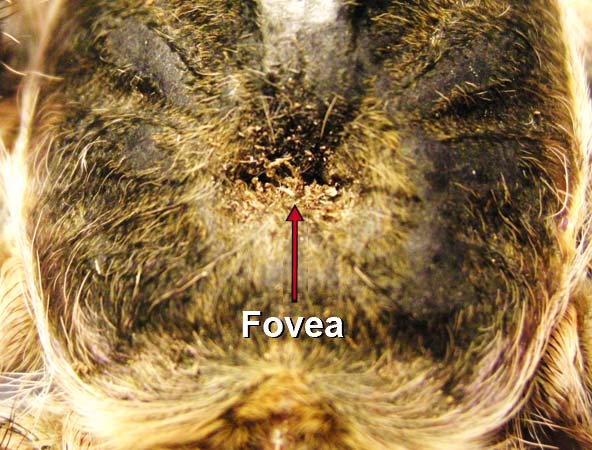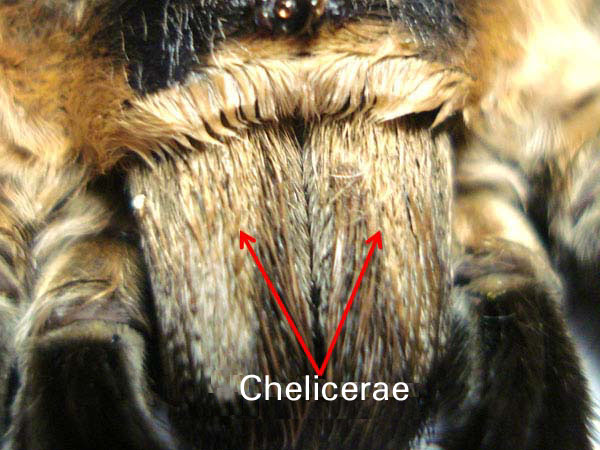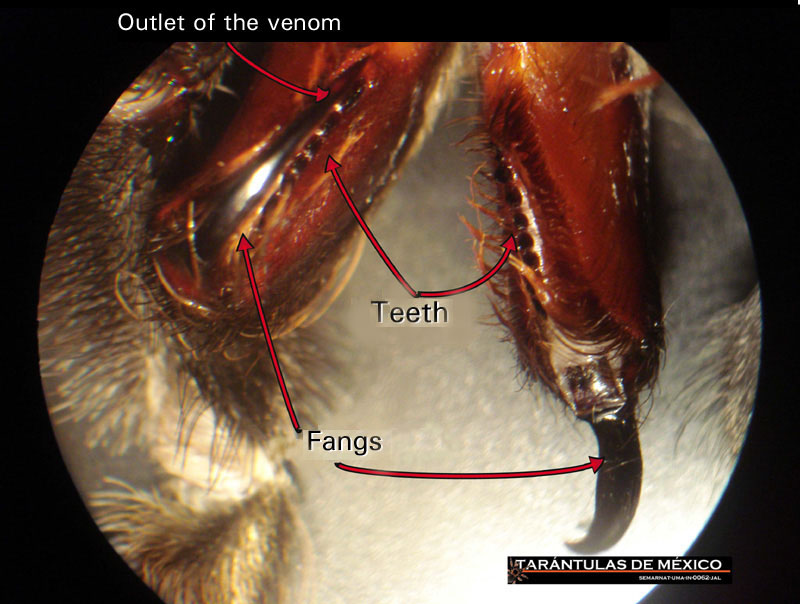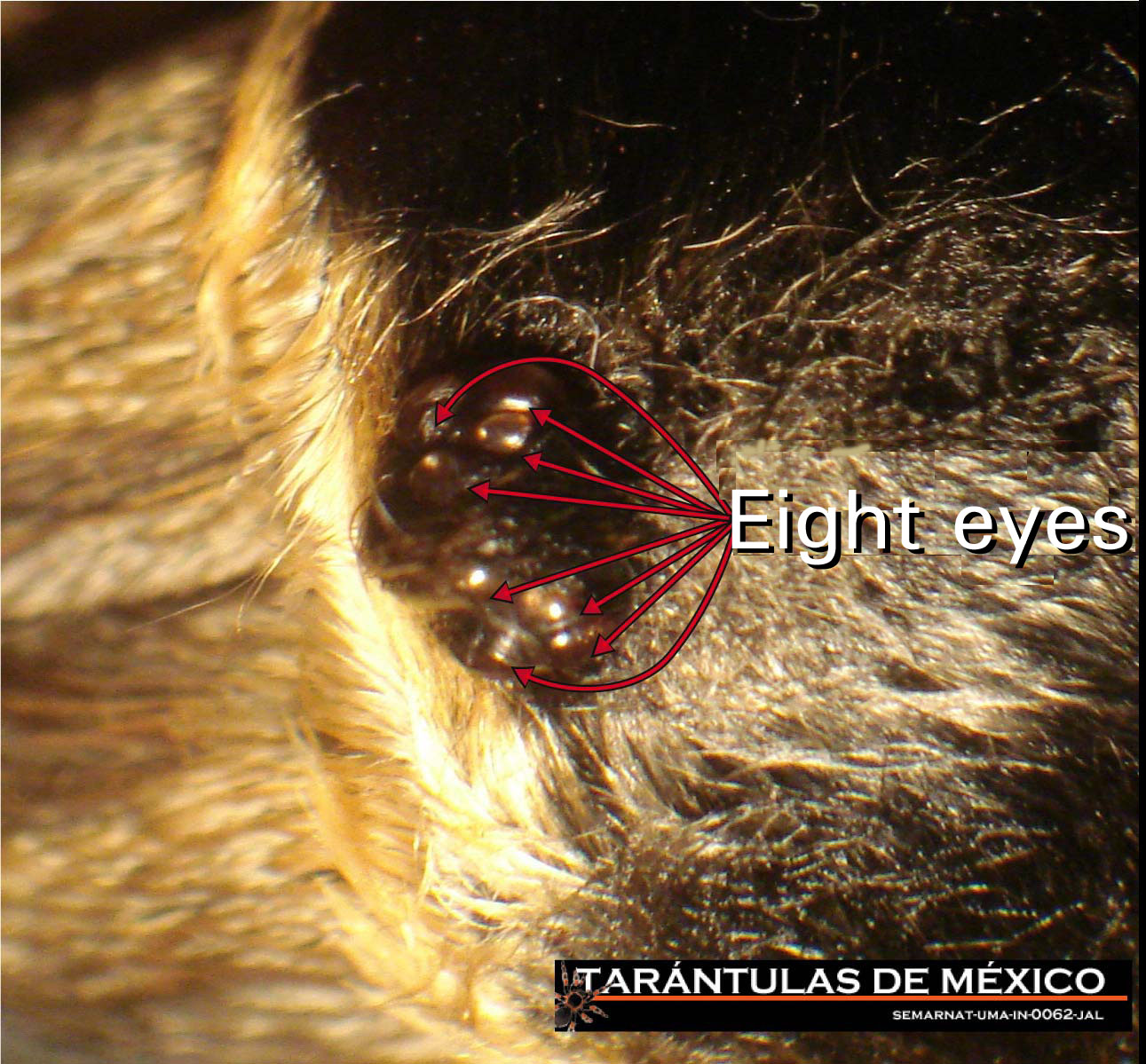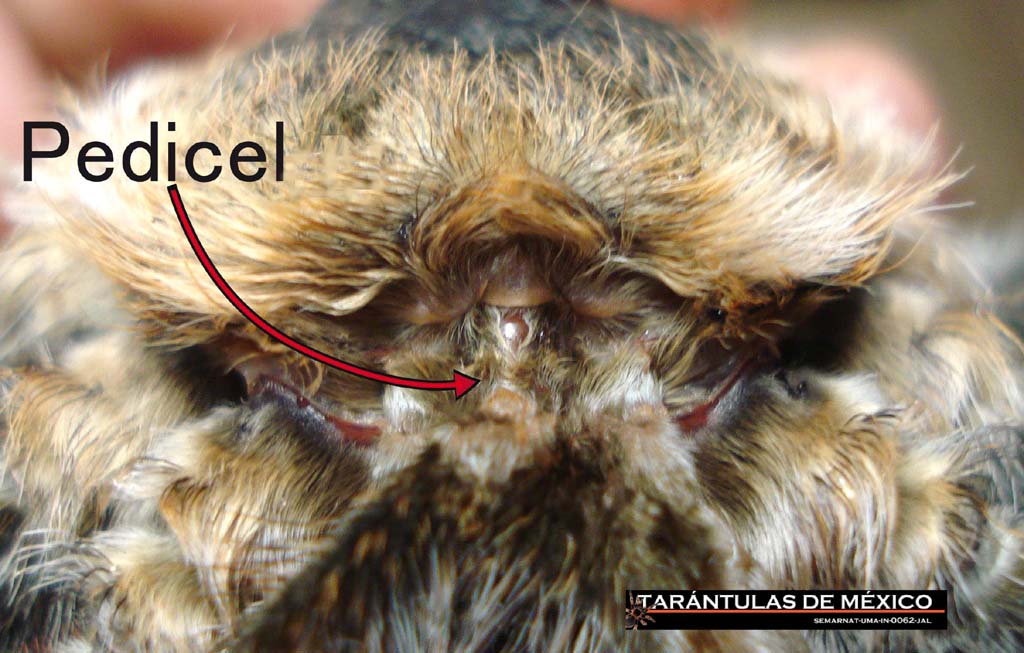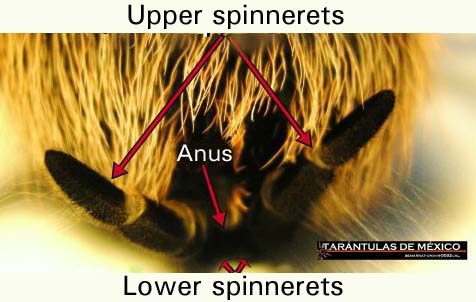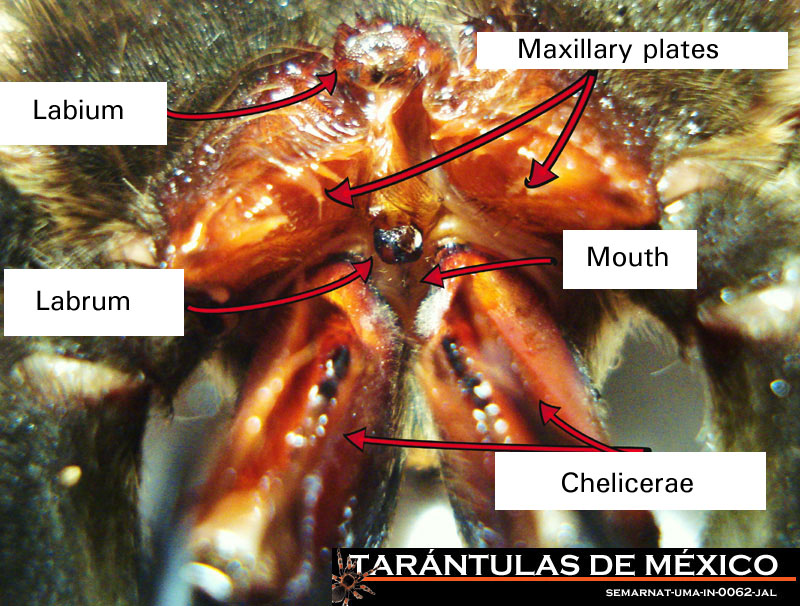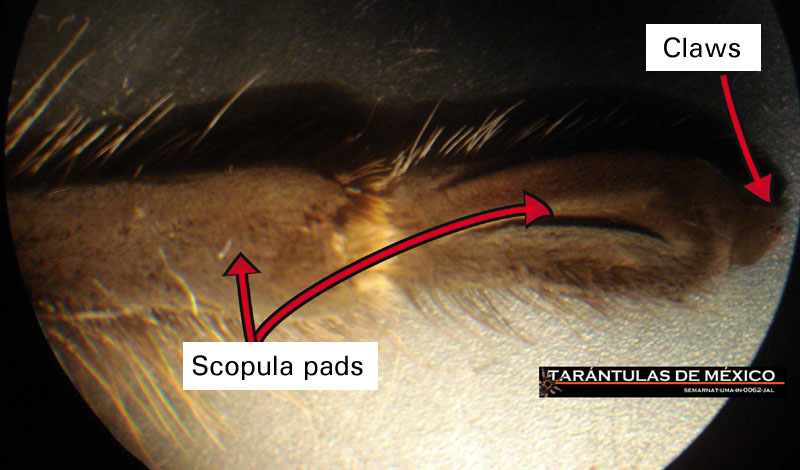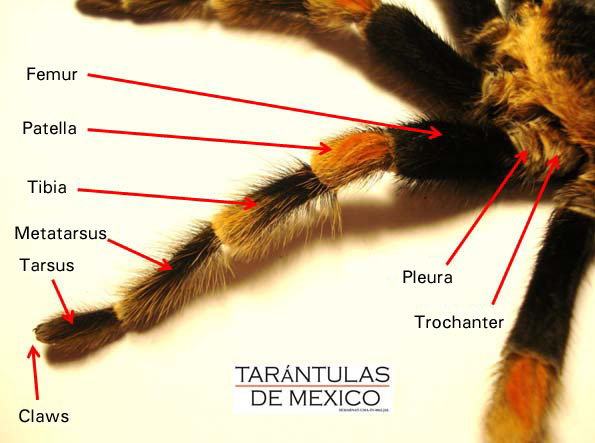
| Home > Taxonomía y anatomía básica de las tarántulas | ||||||||
|
Taxonomy and Anatomy of Tarantulas Taxonomy: Without going into great detail, I will explain the taxonomy of tarantulas. This is very important if you want to know who their cousins and close relatives are, and tell them apart by their features. They belong to the animal kingdom, and then to the phylum arthropoda (articulated limbs), encompassing invertebrate creatures with an exoskeleton (external skeleton) made by a protein called chitin that has excellent impermeable and hardness qualities, but restricts their growth and requires them to shed and change skeleton periodically. Invertebrates are the most numerous animals that have ever existed on the face of the earth, and can be found in every corner of our planet. From here, they branch into seven classes, of which the most important by number are the crustaceans (shrimp and crabs), the miriapods (millipedes and centipedes), insects, and arachnids. Arachnids are divided into 11 orders, including scorpions, solifuges, amblypigi, and, of course, the order araneae (spiders). The order araneae is divided into two large branches or infraorders: The Araneomorphae, called true spiders, where the vast majority of spiders are included; and the Mygalomorphae, where the tarantulas are classified. An easy way to tell an arachnid apart from an insect is the number of body parts. Insects have three body parts, and arachnids have only two. And something even easier to see is that insects have only 6 legs, while arachnids have 8. An arachnid will never have antennas, while all insects have them. Something even more important is that most insects have wings, and there are no arachnids that have them! How can you tell between a true spider and a Mygalomorphae? By the way they open and close their chelicerae (equivalent to jaws) and their fangs. True spiders open and close their fangs crossing them, while mygalomorphae (among them, tarantulas) close them in parallel. | Top of page | Anatomy: A tarantula has 8 legs and a pair of pedipalps that are not used for locomotion, but rather for smelling, hunting, and feeling vibrations, and for males, to copulate. Their bodies, as in all other arachnids, are divided into two sections joined by a pedicel. On the tarantula’s exterior, the front part, or prosoma, has the fangs, the four pairs of legs, and the pair of pedipalps, as well as the eight eyes that in most tarantulas only help them distinguish light. On the back part, or opisthosoma, there are four openings for the book lungs, a genital groove called epigynium, the spinnerets that produce the silk, and the anus.
Click on the following image labels to go to each description
PROSOMA Inside the prosoma, we can find the mouth located between the chelicerae, and then the esophagus. Next is the stomach that is like a vacuum suctioning all the food through the mouth that filters out anything larger than a micron. Tarantulas inject their prey with a saliva that has special chemicals that break all protein chains liquefying the prey, and then they literally absorb it. Another organ found in the prosoma is the brain. This organ is divided into two large ganglia that run nerve channels throughout the entire body. Actually, among all arthropods, tarantulas have the largest brains. The large retractor muscles that support and provide mobility to the limbs are fixed inside the prosoma. But, why are they called retractors? We will see this later. OPISTHOSOMA Inside the opisthosoma, we can find the rest of the digestive system, the glands that produce the different types of silk, the ovaries in females, and lastly, working together, the book lungs and the large heart. Why are they called book lungs? Because they happen to be shaped just like a book. These lungs don’t move, but let air flow freely within them, exchanging gases with the tarantula’s hemolymph, that will be pumped by the heart through an open irrigation system. Tarantulas and all arthropods, instead of blood and lymph, have a liquid called hemolymph, which is a blend of both, that works in an open system where, once it enters the heart, it is pumped through a series or arteries, and then released throughout the entire body oxygenating and feeding all the cells. This is why, when a tarantula accidentally breaks its exoskeleton, the hemolymph can drain through the hole and cause death, unless this leak is somehow stopped. Another important function of the hemolymph is related to locomotion. How? The muscles retract the limbs, and the internal pressure created by the hemolymph is what makes them stretch out. This means that they have a complex and efficient hydraulic locomotive system! This is the reason you will see that, when a spider or tarantula dies, the lack of hydraulic pressure from the heart and hemolymph will make it retract its legs. | Top of page | FOVEA In most cases, the fovea is a large depression, although, in genus Sphaerobothria and Ceratogyrus it looks more like an outward extension shaped like a small horn. Some authors try to tell species apart by the difference in this depression. However, this feature can change with the molting process, and doesn’t make it a very reliable way to identify a species. | Top of page |
CHELICERAE
These large sclerotic instruments are very important for the tarantula because they serve several basic functions. One of the main functions is to house the fangs used to inject the venom into their prey. Inside the chelicerae, the venom glands can be found. These glands produce the venom, and are connected to the fangs through a duct, with a tiny outlet almost at the tip. Another function they perform is mastication. When the tarantula is eating, it releases special saliva that unfolds proteins in the prey´s flesh, making a protein shake that will be suctioned by the stomach. This mastication is very meticulous, and is done by tiny teeth located in the inside of the chelicerae. The tarantula’s mouth is so small, it can’t absorb solid pieces. Around the mouth, there are bristles that filter the food before it is absorbed. Since they are very strong, chelicerae are also used to dig and transport the soil from the den with the help of the pedipalps, and sometimes to break roots that get in their way.
We should also mention that, sometimes, they use their chelicerae to aid locomotion, holding on with them to climb steep walls. As you can see, there are very useful tools for them, and it is ridiculous and stupid for some clandestine dealers to break off the chelicerae to supposedly remove the venom, oblivious to the great harm they are inflicting on the tarantulas.
| Top of page | OCULAR AREA | Top of page | PEDICEL
| Top of page | ESPINNERETS Tarantulas have four spinnerets: The two lower ones are small, and the higher ones are larger and very mobile. Tarantulas give several uses to the silk they weave. They use is as a place mat when they eat; to protect the wall in their dens; and tree-dwellers use it to build their entire burrow. Females make their egg sack with a beautiful pure white silk. Some tarantulas leave their webs outside their dens to detect prey, to leave pheromones and make their presence known to suitors; and to cover the entrance to their burrows protecting them from predators and the environment. | Top of page | Click on the following image labels to go to each description
MOUTH Before going through the tiny mouth, the liquid will have to pass through the hairs in the maxillary plates that filter all that protein soup with the help of the upper lip or labium and the labrum. All these parts work together in an incredible way. This is a slow but highly effective process. The next step is for the stomach, with its suctioning properties, to absorb all this nourishing liquid. SCOPULA PADS It is worth mentioning that in some tarantulas, such as the Aphonopelma seemani, their scopula pads have the capability of producing silk threads, which makes for an even better grip, leaving a trace of silk where they walk and feel they need additional gripping power.
LEGS Tarantulas have four pair of legs numbered in Roman numerals from I to IV, from front to back. Each leg has the following eight sections: Claws, tarsus, metatarsus, tibia, patella, femur, trochanter, and coxa. The coxa is where the leg and the prosoma come together. All these unions have a ligament called pleura, which is very elastic, but resistant and water-tight at the same time, making articulation possible.
Every leg in moved by about thirty muscles, but the odd thing is that they only work for retracting movements, and not extending ones. Tarantulas can extend their legs relying on the hemolymph pressure, and retract them using their muscles. With this explanation we can reach two conclusions: A tarantula can’t run long distances because the hemolymph used for locomotion is also used to transport oxygen and nutrients, so it has to stop every once in a while to perform this process; and second, that this is the reason why, when arachnids die, they fold their legs in because of the lack of hydraulic pressure. A dehydrated tarantula has difficulty walking.
Females will not, but males of the great majority of species will develop tibia hooks during their last molt, as you can read on the section on Biological Cycle and Reproduction, that will help them control the females by holding down their chelicerae in case she has second thoughts. PEDIPALPS Pedipalps are the front limbs, but since they are not meant for locomotion, they can’t really be considered as legs. And, unlike legs that have 8 sections, these only have seven. These limbs are very important because they act as a type of antenna to help them find their way, as well as locate their mate or prey. Pedipalps are in great part covered by trichobothria. It is thought these specialized bristles that cover several body parts are very sensitive to temperature, odors, and changes in pressure. In the males, as you can see in the section on Biological Cycle and Reproduction, they skillfully use their pedipals during copulation, because on the tip they have the spermatic hooks previously filled with sperm, as explained on the Sexing section.
| Top of page | |

